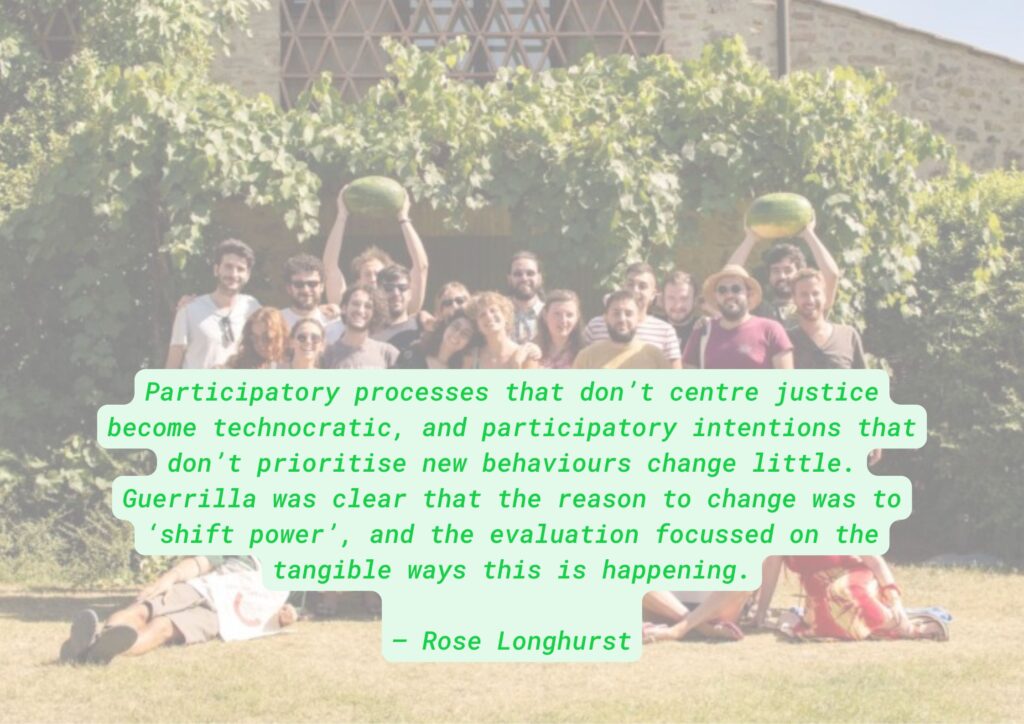Reviewing Guerrilla’s participatory grantmaking model
I was born in Manila, the world’s most densely populated city, before I moved to the English countryside when I was six. Metro Manila resembles Megacity One from the Dredd comics – with a population of more than 26 million and more than 20,000 residents per square kilometre. The English village I moved to has around 700 residents, and is 14 kilometres from the nearest shop. When thinking of my professional trajectory, the differences I encountered in my home life as a child are as striking as the contrasts I have later reckoned with in work. I had been working for a Megacity funder with offices spread across the globe and a staff body as dense as that Megacity metro line. When I recently got to be involved with the Guerrilla Foundation, it felt like I was back in my English village. Yet, just as both my childhood homes shared many similarities, the Megacity funder and Guerrilla share many grantees, despite their functioning in radically different ways.
In 2022, Guerilla Foundation developed a participatory grantmaking (PGM) framework, where, among other things, it established an Activist Council to review and decide on Action grants. Two years later, I was asked to evaluate this approach, coordinating a working group that included one member of the Funders Circle and two members of the Activist Council. We heard from 123 folks part of the Guerrilla community to understand ‘What’s changed, What needs to, and What difference does participation make?’
From a personal perspective, I’m interested in what’s shared and what’s different between the ‘Megacity’ and the ‘village’ approach to funding social justice. The Megacity and Guerilla share a similar background: a wealthy person who wanted to address inequality chose people he trusted to help redistribute his wealth for this purpose. Unlike FundAction, FRIDA Fund and others, Guerrilla was not designed and established as a participatory grantmaker, but instead intended to transform itself along these principles. This is one major insight from the evaluation: unlike the vast majority of philanthropic foundations who never question their role, legitimacy or impact in the ecosystem, Guerrilla takes these issues seriously. Not only that, but unlike those progressive foundations that endlessly beard-stroke about the need for change, Guerrilla actually acts. The vision, ambition and action of Guerrilla is almost unique for a funder, especially one that could’ve easily continued in perpetuity without transformation.
Navigating the field of participatory grantmaking
Having worked in ‘participatory grantmaking’ since before it was called so, I’ve seen the term misused by the ill-informed and the ill-intentioned. A wealthy person inviting someone almost identical to them (bar the amount of melanin in their skin) to join their foundation is not participatory philanthropy. (The new Advancing Participation in Philanthropy Toolkit is a helpful resource for assessing whether a foundation’s attempts at participation is within the field’s threshold.) One of the key outcomes of the Guerrilla review is that the participation of activists in Guerilla’s process goes well beyond tokenistic approval. They are shaping Guerilla in meaningful and fruitful ways. Their contributions matter, and the remit of their mandate is growing. Participation is about agenda-setting and joint strategy making, not voting on predetermined outcomes.
Participation is also about politics, and its consequential processes. Participatory processes that don’t centre justice become technocratic, and participatory intentions that don’t prioritise new behaviours change little. Guerrilla was clear that the reason to change was to ‘shift power’, and the evaluation focussed on the tangible ways in which this is happening. Here, the evaluation held lessons for all of us. Whilst the good intentions of everyone involved are felt, there was a repeated request to move beyond ‘trust’, to ‘accountability’.

Moving from trust to accountability
While the evaluation showed there’s a great level of trust in Guerrilla, there is a palpable need for more legible internal processes that reflect that trust in concrete frameworks around who makes decisions, why, and how. As the number of decision-makers in Guerrilla grows, there needs to be a commensurate growth in professionalism. This is not unique to Guerrilla; any collective which has had one mode of operation needs to work hard to support newcomers to understand, question and change this existing mode (also what some of us would call analysing path dependency). This includes codifying intentions that are usually assumed, or – as several folks in the evaluation noted – ‘making the implicit explicit’. Resources need to be invested to ensure folks at the foundation feel comfortable and empowered to challenge and change things in their work domain. An over-reliance on ‘trust’ rather than accountability mechanisms is fundamentally power-blind.
This is one of the few areas where my experience with Guerrilla echoes that of my experience in the Megacity funder. The resistance to any formal evaluation, accountability and learning processes in the Megacity was due to the pervasive belief that only a fool wouldn’t ‘know’ that they were doing the right thing; that these processes were both unnecessary and a distraction from the urgent work of changing the world. At the time, my decision to bring in ‘outsiders’ for evaluation and strategy was met with derision by many in the Megacity. Whilst this is obviously not the case at Guerrilla – one of the most reflective funders I’ve come across – there is still the sense that if we can trust that funding is going to the ‘right’ places, then that is enough.

Grantmaking strategy and selection criteria evolution
In terms of where the funding is going, there is evidence that the introduction of the Activist Council has shifted things to more marginalised contexts (for example, with fewer grants going to the relatively-well-funded UK). Guerrilla, like all values-led funders, seeks to fund those groups led by people affected by the issues, not on behalf of. The review shows that significantly more grants are going to groups of marginalised communities than previously. That said, the substance of what’s being funded doesn’t appear to have significantly changed since 2022. It’s how the decisions are being made that is the real shift.
For funders that approach their work with respect towards the communities it resources, this ‘how’ matters. The approach of centering the insights of people who have direct experience of the issues was welcomed by grantees as well as staff and funders. Not only is it normatively more legitimate, it is more effective, and the evaluation shows that Guerrilla’s approach improves with current local knowledge and collective intelligence, next to offering movement-building benefits.
The How is Now
As Guerrilla takes the next months to digest and continue extracting outcomes from their model’s review, we conclude with a call-to-action for those inspired by this work. Hopefully you’re already supporting movements fighting for systemic change. (If not, you should.) But are you thoughtful about how you do this? Unlike in the Megacity, people (even rejected applicants!) trust and respect Guerrilla. Both may have funded the same grantees, but the relationships couldn’t be more different. The culture is as different as Manila is to an English village. Unlike many organisations working on social change, Guerrilla’s direction is increasingly being set by people with relevant expertise, rather than people with excess wealth. Furthermore, Guerrilla has had the courage to undertake the self-reflection, continuous learning and commitment to action that is as rare in social justice funding as thatched cottages are in Megacities.




